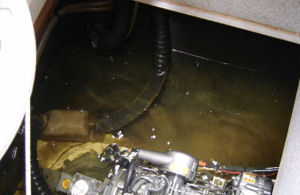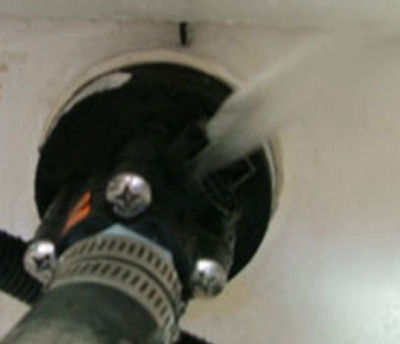New and Used Boat Leak Inspection
"My new boat leaks!"How often does a customer purchase a brand new boat, only to find that the first time they put it in the water it has a leak? It happens more often than one might think. Boat manufacturers do their best to ensure this doesn’t happen, but it still does. Why, you might ask? There are several different reasons why leaks occur.
It pays to check your new boat’s bilge as you never know what you might find.
Anytime a hole is drilled in the hull of a boat below the waterline there is potential for a leak. Most boats have a minimum of two intakes and two outlets below the waterline. There is a drain plug on most trailerable boats. Typically, intake waterlines are for cooling of inboard engines and for livewells on fishing boats. In all instances, some sort of through hull fitting, hose, hose clamp, and pump are installed, and if not done properly, it will leak.
Much the same goes for exhaust hoses on inboards, bilge, baitwell discharge and even cockpit scupper drains. The buyer of any boat new to them must first check for possible leaks.
Why Does a New Boat Leak?
Why does a new automobile have a fan, electric seat, or some other detail that doesn't work? The answer is because someone building the boat made a mistake. During the installation of a through hull fitting, a sealant is placed around the fitting. If the person doing it misses a spot, it will result in a leak, however small the spot may be. A hose clamp might not be tight.
In the automobile business these problems used to be called "Monday Morning Cars." In the boat business, it's more likely to be because someone forgot to finish a job before taking a lunch break, or when knocking off on Friday afternoon.
Boats are built by human beings, not robots, and when the lunch bell rings, or nature calls, or any number of other things occur a moment's distraction can mean that the sealing job didn't get done properly. If not tightened properly, the hose that attaches to the fitting or pump will also result in a leak.
While very few people buy a new boat that they don't have faith in, don't assume that the builder has put the boat through rigorous testing; some companies do, but many don't. So no matter how good you think your boat is, you must be vigilant.
A two-part plastic thru-hull fitting which is cracked and leaking water.
Plastic Fittings on Livewells
Livewell pumps are typically a two-piece cartridge-type design, the base is screwed into the bilge area and the pump snaps together. A common issue that happens with this design is either the two pieces are not fully snapped together, or one piece of the plastic is cracked resulting in a leak. (See the picture above.)
Many manufacturers have a tank in which they “water test” their boats. They check for leaks and test pumps in the tank. But even then, small leaks may get overlooked.
New Boat Check Out
We recommend that when you first take delivery of your new boat, familiarize yourself with every through hull, even those above the waterline. Know where they all are and exactly what they do. Once your boat is first put in the water -- even if done by a dealer who has promised that he has checked out your boat -- before going anywhere, visually check each one of your thru-hulls.
If there is a ball valve, open and close it to make sure it works easily. Make sure all hoses leading to thru-hulls below the waterline are double hose clamped. Make sure the clamps are tight and not broken. These all-important clamps are easy to break. Then, check to see if there is, any water in your bilge. If there is pump it out and sponge up any remaining moisture.
Decks can leak, too! A leak below the waterline can be catastrophic, but a leak on deck will be a constant annoyance that can cause superficial damage, and the water will end up in the bilge sooner or later. Leaks from portlights, hatches, and through-deck hardware are the place to check. Run a garden hose at all of these possible leak areas for 30 minutes, then check below for leaks.
The problem with deck leaks is that they can be very difficult to find, as water can enter one place, run along an inner liner or overhead, and exit many feet away.
We recommend that with a new boat that leaks in the top or bottom that you immediately take it back to your dealer for fixing while under warrantee.
Become an Expert About Liquid in Your Bilge
Once you return from your first outing and before you leave the boat at the dock or put it on your trailer, inspect your bilge again. Is there liquid in the bilge? If there is, ask yourself where it came from. Track down the source. Smell and taste the liquid. It could be from any one of a number of sources, including your water system, deck runoff, engine coolant, a bait well leak, a sterndrive bolt not properly sealed, gray water sloshing out of sump pan, or even a leak in the fuel line that has mixed with water. Once you have discovered the source have it fixed immediately.
Sooner or later you are going to accumulate water in your bilge; that is almost guaranteed. Most leak issues are usually minor and can be fixed by the service department at your dealership. But it is important to acquaint yourself right from the beginning about what to expect, then, when something out of the ordinary appears, you will immediately know for certain that you have a problem.